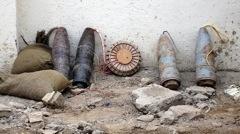
Someone really needs to write a “History of the Improvised Explosive Device”—the IED—covering the period since September 11. This seems like a much-neglected aspect of the Long War—or whatever you want to call it—that hasn’t really gotten its due. Take some of the ominous reports that have cropped up in the news over the past few weeks:
- Two American Seabees killed by a roadside bomb on the Philippine island of Jolo at the end of September—a particularly nasty development when you consider that the various Islamist guerillas in the Philippines haven’t been up to much with IEDs until now.
- U.S. military officials publicly noting that the North Koreans, of all people, have decided to shift resources into making IEDs that could be used against U.S. and South Korean forces if war breaks out on the peninsula (or, much more likely, if Kim’s regime falls apart).
- Coalition casualties in Afghanistan caused by IEDs going up sharply—which suggests that the Taliban and its allies have been learning from the Iraqi insurgency.
The planting of roadside bombs is not a new tactic. The Provisional IRA used it against the British throughout the Troubles—most notoriously, perhaps, in the Warrenpoint Ambush in 1979, when the Republicans used a double bomb attack to kill 18 British soldiers. The Tamil Tigers also found IEDs to be extremely effective in their war against government forces in Sri Lanka.
The Chechen rebels made extensive use of roadside bombs against the Russians there—as shown in this video montage by Chechen jihadis. (Which is one reason why I felt a bit of deja vu when I first found myself in Iraq in 2003. The Humvees we were riding around in were using jammers to block the detonation signals that guerillas might be trying to send—sometimes using cell phones or garage door openers—to bombs hidden in the roads we were driving over. I’d experienced the same thing with the Russians in Chechnya.)
We should have anticipated back in 2003 that Iraqi insurgents might start using IEDs. Iraq was awash in Saddam-era munitions, most of them from military storage depots that the American invaders and their allies failed to put under effective guard. (The main reason for this negligence was the lack of sufficient troops on the ground—so the epidemic of IEDs that followed over the next few years should also be viewed, in part, as a result of Rumsfeld’s planning errors.)
And yet for some reason insurgents outside of Iraq such as al-Qaeda in Saudi Arabia and Yemen haven’t been all that eager to follow suit—perhaps because they didn’t have the “luxury” of piles of high-explosive shells lying around in the countryside that could be converted into IEDs. In any case, now that they are picking up on the idea, it’s not something that bodes well for American forces around the world. The U.S. Army has spent billions trying to develop an antidote to IEDs—even sharing some of it with the Iraqi government itself. All of which has inevitably impelled the bomb-makers in Iraq to come up with ever-more sophisticated designs of their own.
It’s not hard to imagine that the Internet has been a big factor in the spread of IED know-how. But if so—why have some groups outside of Iraq been so slow in putting it to use? And why are they only starting to do it now? Figuring out the answer to that might help to save some lives. So maybe this is something the anti-IED experts in the U.S. military are already studying. On the other hand, maybe they’ve had their hands full as it is.

